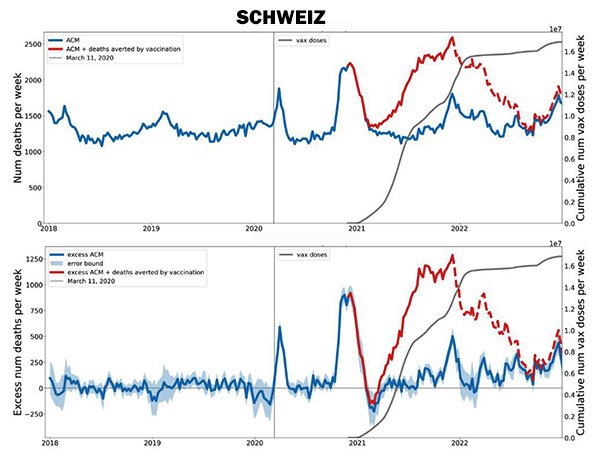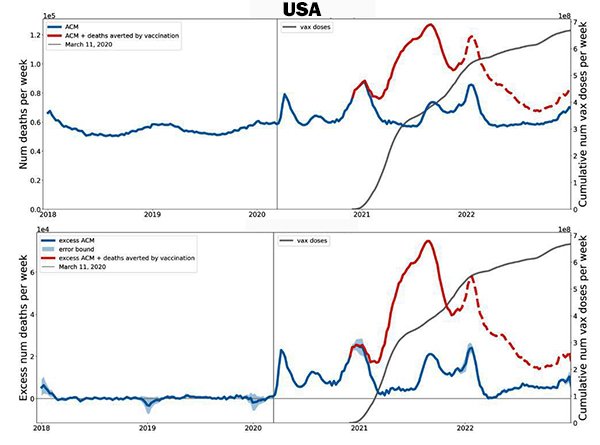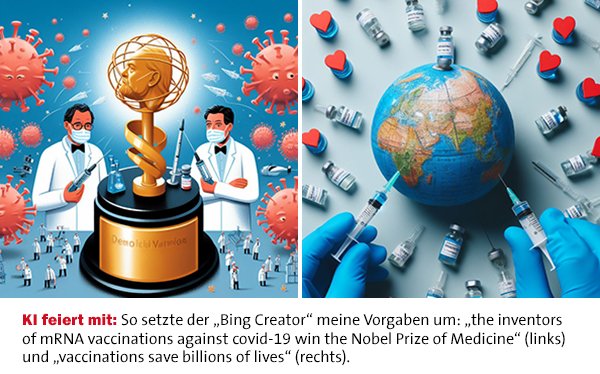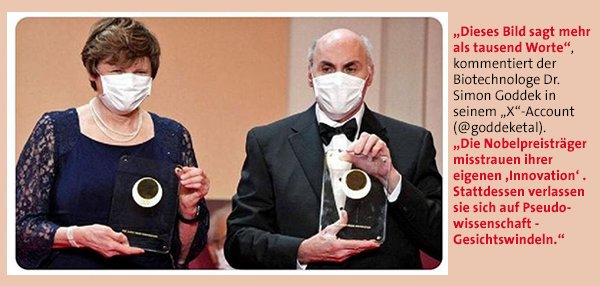by Dr.Harald Wiesendanger– Klartext
What the mainstream media is hiding
Have mRNA vaccines against Covid-19 “saved millions of lives”? That’s why the 2023 Nobel Prize in Medicine was awarded. It honors a hair-raising lie “based on a junk simulation financed by industry,” according to two scientists from Canada.

It has now been quoted over 700 times in the specialist press worldwide, and mainstream media and fact-checkers pass it on without criticism: the study published in the journal The Lancet in 2022, which allegedly “proved” using mathematical models that the newly developed mRNA “vaccine” against Covid-19 saved the lives of up to twenty million people. The six authors, led by Oliver Watson from Imperial College in London, thus provided the decisive reason for honoring two key developers of these “effective vaccines” with the Nobel Prize in Medicine.
This award is an unbelievable scandal, says Denis Rancourt, a former physics professor who was a senior scientist at the University of Ottawa for 23 years and who now works together with his colleague Joseph Hickey for the Canadian organization Correlation Research in the Public Interest. The two expose the mathematical model underlying the Lancet publication as “deeply flawed” and the conclusions from it as “invalid” – “the opposite of good science.”
“The opposite of good science”
If the Lancet model were correct, the global mortality rate would have suddenly risen to massive, historically unprecedented levels in the year after the outbreak of the pandemic, as long as no vaccines were yet available. However, from the end of 2020, once the mRNA vaccines were on the market, these unimaginably high mortality rates should have fallen almost entirely back to baseline levels.
These claims, according to Rancourt and Hickey, “have no connection to actual mortality” but are based on “wild” assumptions. They did not come true in any of the 95 countries examined. Everywhere in 2020, without vaccines, there were increases in mortality rates at best as a result of the mass use of ventilators in intensive care units as well as during and after lockdown phases in which life-saving operations and therapies were not carried out – but no sudden spike in death rates, as one would expect from a “killer germ “would expect, to which humanity is unprotected “at the mercy of.” Nor did mortality rates fall significantly after the vaccination campaign began, eventually reaching four-fifths of the world’s population. Four examples:
GERMANY

Upper panel: All-cause mortality by week, 2018-2022, measured (blue), calculated according to Watson et al. (2022) (red-solid), continued (red-dashed). Lower panel: excess all-cause mortality, with statistical uncertainty (shaded blue). In both panels: cumulative COVID-19 vaccine administration (all doses) (dark gray), date March 11, 2020 (vertical gray line). Source: Denis Rancourt, Ph.D., and Joseph Hickey, Ph.D.
SWISS

AUSTRIA

USA

Nowhere is there “a visible decline in actual all-cause mortality” related to the rollout of the vaccines. Instead, write Rancourt and Hickey, “the opposite is observed, with excess mortality proportionally associated with introduction.”
A research group led by Rancourt had documented this disaster in a hard work published in mid-September: As data from 17 countries in the southern hemisphere – with 10.3% of the world’s population – show, there was an unprecedented increase in overall mortality everywhere with the start of the vaccination campaigns, with 1 Death per 800 injections. 13.5 billion injections administered by early September 2023 produced 17 million Covid “vaccine” deaths worldwide, the research group estimates. “This would be equivalent to an iatrogenic mass event that killed 0.213% of the world’s population while measurably preventing any deaths.” (See: “Jabbed to Death”)
“The Nobel Prize is an establishment propaganda tool.”
How can it be that scientists whose work, contrary to outrageous justification, causes so much harm can have the reputation of having “done the greatest benefit to humanity in the past year”? Alfred Nobel once set this criterion for the award of the prize he founded.
At least Rancourt isn’t the least bit surprised. As he explained in a recent livestream, the Nobel Prize is a powerful political tool. “Although there are some exceptions where Nobel Prizes have recognized significant scientific achievements, they are generally an establishment propaganda tool to convince people what things they must believe to be absolutely true, absolute advances in human knowledge.”
“This not only has an impact on the public,” complains Rancourt, “but also on the scientists themselves.” Because it influences what they are convinced of, as well as what they research, why, and towards what goal.

AI celebrates with us: This is how the “Bing Creator” implemented my specifications: The “inventors” of mRNA vaccination against COVID-19 won the Nobel Prize of Medicine (left), and “vaccination saves billions of lives” (right)
“The Nobel Prize committee itself must have been clueless, unscientific, must not have questioned anything, must have been looking for something, a prize that they wanted to give, and not bothered to think for themselves about whether it made any sense or not. And then they repeated this ‘millions of lives saved’ thing, which is nonsense. (…) There is no scientific basis for this statement. No clinical study has ever shown this. And it’s based on an industry-funded junk simulation where the authors didn’t even check whether their results even made sense. (…) The result is that a terrible product that should never have been injected into human bodies is now something we will celebrate” – as an “achievement of human science.” Hasn’t this made a fatal preliminary decision as to how the WHO and its member states will react to the next pandemic?

“This picture says more than a thousand words,” commented biotechnologist Dr Simon Goddek in his X Account (@goddeketal). “The Nobel Prize winners distrust their own “innovation.” Instead, they rely on pseudoscience – facial diapers.”
“The Nobel Prize committee itself must have been clueless, unscientific, must not have questioned anything, must have been looking for something, a prize that they wanted to give, and not bothered to think for themselves about whether it made any sense or not. And then they repeated this ‘millions of lives saved’ thing, which is nonsense. (…) There is no scientific basis for this statement. No clinical study has ever shown this. And it’s based on an industry-funded junk simulation where the authors didn’t even check whether their results even made sense. (…) The result is that a terrible product that should never have been injected into human bodies is now something we will celebrate” – as an “achievement of human science.” Hasn’t this made a fatal preliminary decision as to how the WHO and its member states will react to the next pandemic?
Incompetent reviewers, biased editors
How could a methodologically preposterous work like the Watson group’s fairy-tale model calculations even find acceptance in one of the oldest and most renowned medical journals in the world? “How did this happen at the Lancet through peer review?” Rancourt marvels. “Who were these assessors? How can they be so blind and incompetent and not question what some authors are doing, which is completely new and fabricated? Aren’t they able to see it?”
“And what about the editors? How do they select these reviewers? Did the editors only consider the reviewers who liked it and ignore the critical reviewers? Are you so scientifically uneducated yourself?”
However, appearances have not only been deceptive since the Corona hype. (1) The fact that peer reviewing ensures quality can be considered a rumor that has long been disproved. Several studies have largely exposed this review as a fraudulent label that leaves the door open to distortions. (2) There is no guarantee of the neutrality of the reviewers. (3) Hardly any peer has enough leisure, ambition, and criminal acumen to investigate every conceivable sloppiness or trickery through persistent, if necessary ruthless, own research – and in the process, possibly expose a valued colleague. Because the reviewers often remain anonymous, no one puts their good reputation in the scientific community at risk if they do not work diligently enough due to lack of time, insufficient interest, or ignorance. Or when he uses his own points of view on controversial topics as a basis for decision-making. Or if he practices “territory protection” – preventing competitors from penetrating his “niche” through weakly justified devaluations. Unnamed, in ambush, established experts are less afraid to suppress unorthodox research approaches and thwart lateral thinkers.
The quality suffers immensely as a result. Nearly a third of peer-reviewed medical studies published between 1990 and 2003 were found to be exaggerated or contradictory upon closer inspection; one in six could not be confirmed by follow-up studies. (4) Above all, How much is a consensus among peers worth if the pharmaceutical industry bribes most of the experts in a field – and thereby undermines the system of mutual control among specialist colleagues? (5) In the meantime, the New England Journal has, of necessity, moved away from the requirement that its reviewers be free of pharmaceutical compounds – the editorial team simply could no longer find enough independent experts. The new standard stipulates that experts must not receive more than $10,000 per year per company in order to be able to assess studies (6) – an unparalleled indictment.
Ordered, paid, delivered
“Tell me who finances a study, and I’ll tell you what comes out of it.”: This disrespectful saying seems to hit the nail on the head, at least in the case of the Watson pseudo-study. The donors included the Bill & Melinda Gates Foundation, the “vaccination alliance” GAVI founded by Gates, the World Economic Forum, and the WHO. Individual co-authors are on the fee lists of vaccine manufacturers Moderna and GlaxoSmithKline as “advisors,” as well as the “Coalition for Epidemic Preparedness Innovations” (CEPI), a Gates-sponsored “public-private partnership” with enterprising prick fetishists.
How can scientists give in to something like that? “They have to be critical of their own ideas and not just rub their hands because they get something that Gates likes,” says Rancourt. Otherwise, academic prostitution takes place.
The same Imperial College in London where the Watson group is up to mischief is, strangely enough, the academic home of one of the windiest virus apocalyptists of the dark Corona years: Professor Neil Ferguson. (See Klartext: “‘Professor Lockdown’ struck” and “Spinnen die Englaender?“) His ludicrous computer simulations, which predicted sky-high Covid corpses for Britain and the rest of the world, were instrumental in fomenting mass panic and inclining hesitant politicians to allow themselves to be ripped off by pharmaceutical giants when negotiating vaccine supply contracts. One of the main supporters of Imperial College is: the Gates Foundation.
(Harald Wiesendanger)
The cover image is made up of two works by Microsoft’s AI “Bing Image Creator.” So, in a matter of seconds, she illustrated a statement that I gave her on October 28, 2023: “vaccinations save billions of lives”. By the way, the requirement “by vaccinations against COVID-19 Bill Gates saved billions of lives” was blocked by the AI as a “violation of content guidelines” – combined with the threat that further violations of this kind could lead to me being blocked.
Remarks
1 For more information, see Harald Wiesendanger: Das GesundheitsUNwesen – Wie wir es durchschauen, überleben und verwandeln, Schönbrunn 2019, chap. 5: “Worth its weight in gold – How trade magazines can be misused for pharmaceutical advertising.”
2 F. Godlee/T. Jefferson: Peer review in health sciences, 2nd ed. London 2003.
3 Alfred Kieser: „Die Tonnenideologie der Forschung. Akademische Rankings“, Frankfurter Allgemeine Zeitung, 11. Juni 2010.
4 John P. A. Ioannidis: “Contradicted and Initially Stronger Effects in Highly Cited Clinical Research,” Journal of the American Medical Association 294/2005, pp. 218–228.
5 Peter Gøtzsche: Tödliche Medizin und organisierte Kriminalität, München 2014, S. 144.
6 Jeffrey M. Drazen/Gregory D. Curfman: “Financial associations of authors,” New England Journal of Medicine 346 (24) 2002, pp. 1901-1902, http://www.nejm.org/doi/full/10.1056 / NEJMe020074, accessed on October 24, 2016.
